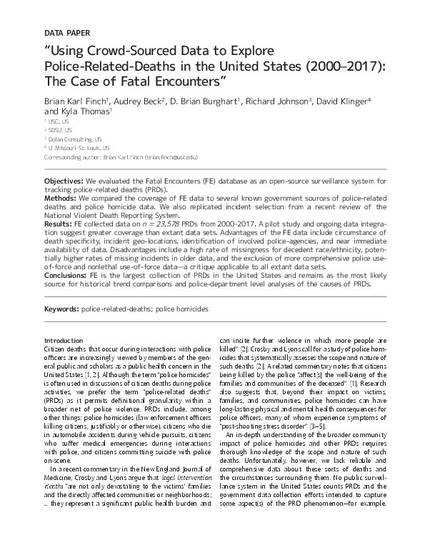
Article
“Using Crowd-Sourced Data to Explore Police-Related-Deaths in the United States (2000–2017): The Case of Fatal Encounters”
Open Health Data
(2019)
Abstract
Objectives: We evaluated the Fatal Encounters (FE) database as an open-source surveillance system for tracking police-related deaths (PRDs).
Methods: We compared the coverage of FE data to several known government sources of police-related deaths and police homicide data. We also replicated incident selection from a recent review of the National Violent Death Reporting System.
Results: FE collected data on n = 23,578 PRDs from 2000–2017. A pilot study and ongoing data integration suggest greater coverage than extant data sets. Advantages of the FE data include circumstance of death specificity, incident geo-locations, identification of involved police-agencies, and near immediate availability of data. Disadvantages include a high rate of missingness for decedent race/ethnicity, potentially higher rates of missing incidents in older data, and the exclusion of more comprehensive police use-of-force and nonlethal use-of-force data—a critique applicable to all extant data sets.
Conclusions: FE is the largest collection of PRDs in the United States and remains as the most likely source for historical trend comparisons and police-department level analyses of the causes of PRDs.
Disciplines
Publication Date
May 7, 2019
DOI
10.5334/ohd.30/
Publisher Statement
DOI: 10.5334/ohd.30
Citation Information
David Klinger, Brian K Finch, Audrey Beck, D B Burghart, et al.. "“Using Crowd-Sourced Data to Explore Police-Related-Deaths in the United States (2000–2017): The Case of Fatal Encounters”" Open Health Data Vol. 6 Iss. 1 (2019) p. 1 - 8 Available at: http://works.bepress.com/david-klinger/33/
Creative Commons license

This work is licensed under a Creative Commons CC_BY International License.
